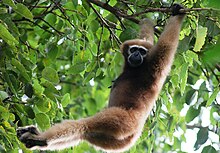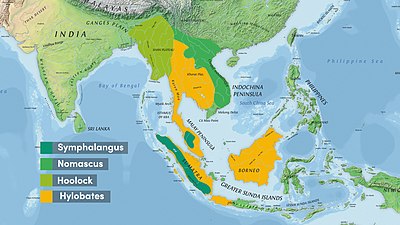
Gibbons are apes in the family Hylobatidae. The family historically contained one genus, but now is split into four extant genera and 20 species. Gibbons live in subtropical and tropical rainforests from eastern Bangladesh to Northeast India to southern China and Indonesia.

Apes are a clade of Old World simians native to sub-Saharan Africa and Southeast Asia, which together with its sister group Cercopithecidae form the catarrhine clade, cladistically making them monkeys. Apes do not have tails due to a mutation of the TBXT gene. In traditional and non-scientific use, the term ape can include tailless primates taxonomically considered Cercopithecidae, and is thus not equivalent to the scientific taxon Hominoidea. There are two extant branches of the superfamily Hominoidea: the gibbons, or lesser apes; and the hominids, or great apes.
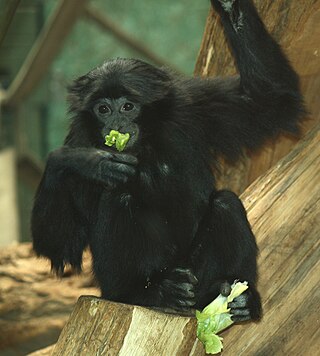
The siamang is a endangered arboreal, black-furred gibbon native to the forests of Indonesia, Malaysia, and Thailand. The largest of the gibbons, the siamang can be twice the size of other gibbons, reaching 1 m (3.3 ft) in height, and weighing up to 14 kg (31 lb). It is the only species in the genus Symphalangus. Fossils of siamangs date back to the Middle Pleistocene.

The lar gibbon, also known as the white-handed gibbon, is an endangered primate in the gibbon family, Hylobatidae. It is one of the better-known gibbons and is often kept in captivity.
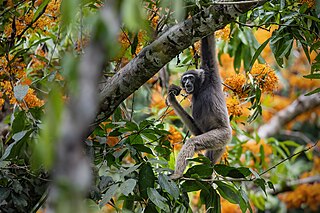
Müller's gibbon, also known as the southern grey gibbon, is a primate in the gibbon family, Hylobatidae.

The genus Hylobates is one of the four genera of gibbons. Its name means "forest walker", from the Greek hūlē and bates.

Nomascus is the second-most speciose genus of the gibbon family, Hylobatidae. Originally, this genus was a subgenus of Hylobates, with all individuals considered to be one species, H. concolor.

The Nokrek National Park, the core area of the Nokrek Biosphere Reserve, is a National park located approximately 2 km away from Tura Peak in West Garo Hills district of Meghalaya, India.The Nokrek Biosphere Reserve along with the Nokrek National Park was added by UNESCO to its list of Biosphere Reserves in May 2009. along with the Balpakram National Park in South Garo Hills. The Nokrek area is a hotspot of biodiversity in Meghalaya. Established in 1986, the National Park area comprising around 47.48 square kilometres is looked after by the Northern Nokrek Range and the Southern Nokrek Range under the East & West Garo Hills Wildlife Division of the Meghalaya State Forest Department under the administrative control of the Government of Meghalaya, India.
Bunopithecus is an extinct genus of primate represented by one species, Bunopithecus sericus, a gibbon or gibbon-like ape. Its remains were first discovered in Sichuan, China, in strata from the Middle Pleistocene.
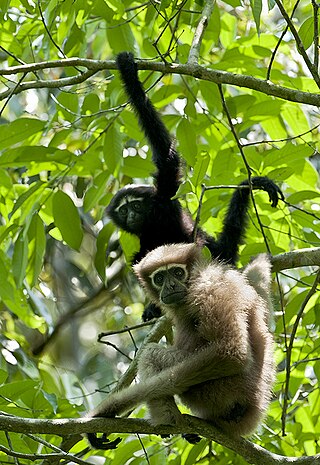
The Hollongapar Gibbon Sanctuary, formerly known as the Gibbon Wildlife Sanctuary or Hollongapar Reserved Forest, is an isolated protected area of evergreen forest located in Assam, India. The sanctuary was officially constituted and renamed in 1997. Set aside initially in 1881, its forests used to extend to the foothills of the Patkai mountain range.

The eastern hoolock gibbon is a primate from the gibbon family, Hylobatidae. It is one of three species of hoolock gibbon. This species is found in east of the Chindwin River, such as the Mahamyaing Wildlife Sanctuary, and in south west Yunnan of China. Recent study published in April, 2021, in International Journal of Primatology confirmed that this species is not found in India as it was thought to be.

The western hoolock gibbon is a primate from the gibbon family, Hylobatidae. The species is found in Assam, Mizoram, and Meghalaya in India, Bangladesh, and Myanmar west of the Chindwin River.
Balpakram is located in South Garo Hills district in Meghalaya, India.

Ficus neriifolia is a species of fig (Ficus). It is native to Asia, including Bhutan, Burma, China, India, and Nepal.
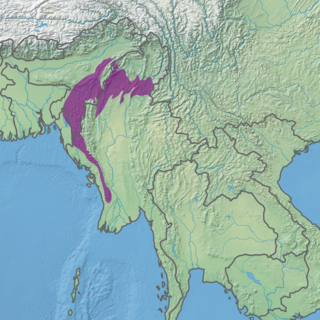
The Mizoram–Manipur–Kachin rain forests is a subtropical moist broadleaf forest ecoregion which occupies the lower hillsides of the mountainous border region joining Bangladesh, China's Yunnan Province, India, and Myanmar. The ecoregion covers an area of 135,600 square kilometres (52,400 sq mi). Located where the biotas of the Indian Subcontinent and the Indochinese Peninsula meet, and in the transition between subtropical and tropical regions of Asia, the Mizoram–Manipur–Kachin rain forests are home to great biodiversity. The WWF rates the ecoregion as "Globally Outstanding" in biological distinctiveness.
The Yunnan lar gibbon, also known as the Yunnan white-handed gibbon, is a subspecies of the lar gibbon, a primate in the gibbon family, Hylobatidae. This Chinese subspecies is thought to be extinct.

Anwaruddin Choudhury is an Indian naturalist, noted for his expertise on the fauna of North-East India.
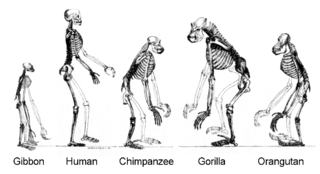
The phylogenetic split of the superfamily Hominoidea (apes) into the Hylobatidae (gibbons) and Hominidae families is dated to the early Miocene, roughly 20 to 16 million years ago.
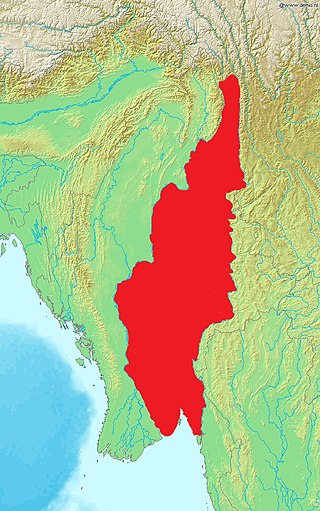
The Skywalker hoolock gibbon or Gaoligong hoolock gibbon is an arboreal primate in the gibbon family, Hylobatidae. It is one of three species of hoolock gibbon and was first described in January 2017 in the American Journal of Primatology. The Skywalker hoolock gibbon is one of two species of Eastern hoolocks: H. tianxing and H. leuconedys. Researchers estimate H. tianxing diverged from H. leuconedys roughly 490,000 years ago. The Eastern hoolock is vulnerable on the IUCN Red List, with a population of 310,000–370,000 individuals. Of this population, H. tianxing makes up less than 150 individuals, making the Skywalker hoolock gibbon an endangered species.
